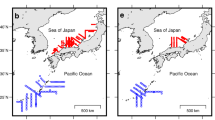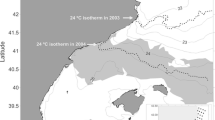Abstract
Processes occurring during early life-history stages influence the year-class abundance of marine fish. We found that the abundance of 1-year-old spring spawning herring is statistically significantly determined by the number of post-flexion herring larvae in the Gulf of Riga (Baltic Sea). The abundance of consecutive developmental stages of larvae: yolk-sac, pre-flexion, flexion and post-flexion strongly correlated with each other, indicating that factors which already influence the yolk-sac stage are important in determining the abundance of post-flexion herring larvae. Winter air temperature before spawning determined the timing of maximum abundance of pre-flexion herring larvae, but not their main prey: copepod nauplii, implying that different mechanisms governing major preconditions for the formation of year-class strength. The abundance of post-flexion larvae displayed a potential dome-shaped relationship with sea surface temperature experienced after hatching. We suggest that increased summer temperatures, which exceed the physiological optimum negatively, affect the survival of post-flexion herring larvae. Overall, future climate warming poses an additional risk to larval herring survival and this may lead to a reduction in those herring stock which rely on recruitment from shallow coastal areas.






Similar content being viewed by others
References
Arula, T., J. Kotta, A. Lankov, M. Simm & S. Põlme, 2012. Diet composition and feeding activity of larval spring-spawning herring: importance of environmental variability. Journal of Sea Research 68: 33–40.
Arula, T., J. Gröger, H. Ojaveer & M. Simm, 2014a. Shifts in the spring herring (Clupea harengus membras) larvae and related environment in the Eastern Baltic Sea over the past 50 years. PLoS One 9(3): e91304.
Arula, T., H. Ojaveer & R. Klais, 2014b. Impact of extreme climate and bioinvasion on the temporal coupling of spring herring (Clupea harengus m.) larvae and their prey. Marine Environmental Research. doi:10.1016/j.marenvres.2014.05.001.
Arula, T., K. Laur, M. Simm & H. Ojaveer, 2015. Dual impact of temperature on growth and mortality of marine fish larvae in a shallow estuarine habitat. Estuarine, Coastal and Shelf Science (accepted).
Bartolino, V., P. Margonski, M. Lindegren, H. W. Lindeholm, M. Cardinale, D. Rayner, et al., 2014. Forecasting fish stock dynamics under climate change: baltic herring (Clupea harengus) as a case study. Fisheries Oceanography 23(3): 258–269.
Blaxter, J. H. S. & G. Hempel, 1963. The influence of egg: size on herring larvae (Clupea harengus L.). Journal du Conseil International Exploration Mer. 28: 211–240.
Cardinale, M., C. Möllmann, V. Bartolino, M. Casini, G. Kornilovs, et al., 2009. Effect of environmental variability and spawner characteristics on the recruitment of Baltic herring Clupea harengus populations. Marine Ecology Progress Series 388: 221–234.
Collins, M., R. Knutti, J. Arblaster, J.-L. Dufresne, T. Fichefet, P. Friedlingstein, X. Gao, W. J. Gutowski, T. Johns, G. Krinner, M. Shongwe, C. Tebaldi, A. J. Weaver & M. Wehner, 2013. Long-term climate change: projections, commitments and irreversibility. In: Climate change 2013: the physical science basis. Contribution of working group I to the fifth assessment report of the intergovernmental panel on climate change [Stocker, T. F., D. Qin, G.-K. Plattner, M. Tignor, S. K. Allen, J. Boschung, A. Nauels, Y. Xia, V. Bex & P. M. Midgley (eds.)]. Cambridge University Press, Cambridge, United Kingdom and New York, NY, USA.
Cushing, D. H., 1990. Plankton production and year-class strength in fish populations – an update of the match mismatch hypothesis. Advances in Marine Biology 26: 249–293.
Durant, J. M., D. O. Hjermann, G. Ottersen & N. C. Stenseth, 2007. Climate and the match or mismatch between predator requirements and resource availability. Climate Research 33: 271–283.
Gaumiga, R., G. Karlsons, D. Uzars & H. Ojaveer, 2007. Gulf of Riga (Baltic Sea) fisheries in the late 17th century. Fisheries Research 87(2–3): 120–125.
Gröger, J. P., H.-H. Hinrichsen & P. Polte, 2014. Broad-scale climate influences on spring-spawning herring (Clupea harengus, L.) recruitment in the Western Baltic Sea. PLoS One 9(2): e87525.
Hjort, J., 1914. Fluctuations in the great fisheries of Northern Europe viewed in the light of biological research. Rapports et Procés-Verbaux des Réunions du Conseil Permanent International pour l’Exploration de la Mer 20: 1–228.
Hjort, J., 1926. Fluctuations in the year classes of important food fishes. Journal Du Conseil 1(1): 5–38.
Houde, E. D., 2008. Emerging from Hjort’s shadow. Journal of Northwest Atlantic Fishery Science 41: 53–70.
ICES, 2014a. Report of the Workshop on the identification of clupeoid larvae (WKIDCLUP), 1–5 September 2014, Hamburg, Germany. ICES CM 2014/SSGESST:04.
ICES, 2014b. Report of the Baltic Fisheries Assessment Working Group (WGBFAS), 3–10 April 2014, ICES HQ, Copenhagen, Denmark. ICES CM 2014/ACOM:10.
Ichthyoplankton Information System [available on internet at http://access.afsc.noaa.gov/ichthyo/StageDefPage.php]. Accessed 17 Jan 2015
Ji, R. B., M. Edwards, D. L. Mackas, J. A. Runge & A. C. Thomas, 2010. Marine plankton phenology and life history in a changing climate: current research and future directions. Journal of Plankton Research 32: 1355–1368.
Kirtman, B., S. B. Power, J. A. Adedoyin, G. J. Boer, R. Bojariu, I. Camilloni, F. J. Doblas-Reyes, et al. 2013. Near-term climate change: projections and predictability. Chapter 11 in climate change 2013: The physical science basis. Contribution of working group I to the fifth assessment report of the intergovernmental panel on climate change. In Stocker, T. F., D. Qin, G. -K. Plattner, M. Tignor, S. K. Allen, J. Boschung, A. Nauels, Y. Xia, V. Bex, & P. M. Midgley (eds), Cambridge University Press, Cambridge and New York.
Kornilovs, G. 1995. Analysis of Baltic herring year class strength in the Gulf of Riga. ICES CM 1995/J:10.
Kristiansen, T., C. Stock, K. F. Drinkwater & E. N. Curchitser, 2014. Mechanistic insights into the effects of climate change on larval cod. Global Change Biology 20: 1559–1584.
Laurel, B. J., T. P. Hurst & L. Ciannelli, 2011. An experimental examination of temperature. Canadian Journal of Fisheries and Aquatic Sciences 68: 51–61.
Llopiz, J. K., R. K. Cowen, M. J. Hauff, R. Ji, P. L. Munday, B. A. Muhling, M. A. Peck, D. E. Richardson, et al., 2014. Early life history and fisheries oceanography: new questions in a changing world. Oceanography 27(4): 26–41.
Möllmann, C., C. Alessandra & M. Edwards, 2011. Comparative analysis of European wide marine ecosystem shifts: a large-scale approach for developing the basis for ecosystem-based management. Biology Letters 7: 484–486.
Myers, A. R., 1998. When do environment-recruitment correlations work? Reviews in Fish Biology and Fisheries 8: 285–305.
Nash, R. D. M., M. Dickey-Collas & L. T. Kell, 2009. Stock and recruitment in North Sea herring (Clupea harengus); compensation and depensation in the population dynamics. Fisheries Research 95: 88–97.
Neuheimer, A. B., R. E. Thresher, J. M. Lyle & J. M. Semmens, 2011. Tolerance limit for fish growth exceeded by warming waters. Nature Climate Change 1: 110–113.
Oeberst, R., B. Klenz, T. Gröhsler, M. Dickey-Collas, R. D. M. Nash & C. Zimmermann, 2009. When is year-class strength determined in western Baltic herring? ICES Journal of Marine Science 66: 1667–1672.
Ojaveer, E., 1981. Influence of temperature, salinity, and reproductive mixing of Baltic herring groups on its embryonal development. Rapports et Proces-Verbaux des Reunions Conseil International pour l’Exploration de la Mer 178: 409–415.
Ojaveer, E., T. Arula, A. Lankov & H. Shpilev, 2011. Impact of environmental deviations on the larval and year-class abundances in the spring spawning herring (Clupea harengus membras L.) of the Gulf of Riga (Baltic Sea) in 1947–2004. Fisheries Research 107: 159–168.
Paulsen, M., C. Clemmesen & A. M. Malzahn, 2014. Essential fatty acid (docosahexaenoic acid, DHA) availability affects growth of larval herring in the field. Marine Biology 161: 239–244.
Payne, M. R., E. M. C. Hatfield, M. Dickey-Collas, T. Falkenhaug, A. Gallego, J. Gröger, P. Licandro, M. Llope, et al., 2009. Recruitment in a changing environment: the 2000s North Sea herring recruitment failure. ICES Journal of Marine Science 66: 272–277.
Payne, M. R., D. R. Stine, L. W. Clausen, P. Munk, H. Mosegaard & R. D. M. Nash, 2013. Recruitment decline in North Sea herring is accompanied by reduced larval growth rates. Marine Ecology Progress Series 489: 197–211.
Peck, M. A., P. Kanstinger, L. Holste & M. Martin, 2012. Thermal windows supporting survival of the earliest life stages of Baltic herring (Clupea harengus). ICES Journal of Marine Science 69: 529–536.
Petrik, M. C., J. I. Rubao & S. D. Cabell, 2014. Interannual differences in larval haddock survival: hypothesis testing with a 3D biophysical model of Georges Bank. Fisheries Oceanography 23(6): 521–553.
Polte, P., P. Kotterba, C. Hammer & T. Gröhsler, 2014. Survival bottlenecks in the early ontogenesis of Atlantic herring (Clupea harengus L.) in coastal lagoon spawning areas of the western Baltic Sea. ICES Journal of Marine Science 4: 982–990.
Putnis, I., B. Müller-Karulis & G. Kornilovs, 2011. Changes in the reproductive success of the Gulf of Riga herring. ICES C.M./H:13.
Pörtner, H.-O. & R. Knust, 2007. Climate change affects marine fishes through the oxygen limitation of thermal tolerance. Science 315: 95–97.
Rannak, L., 1971. On the recruitment to the stock of the spring herring in the North-eastern Baltic. Rapports et Proces-Verbaux des Reunions du Conseil International pour l’Exploration de la Mer 160: 76–82.
Suursaar, Ü., T. Kullas & M. Otsmann, 2002. Flow modelling in the Pärnu Bay and the Kihnu Strait. Proceedings of Estonian Academy of Science 3: 189–203.
Acknowledgments
The authors would like to thank two anonymous reviewers and the editor for their comments that helped to improve the quality of the article. We are also very grateful to Catriona Clemmensen-Bockelmann and Matthias Paulsen for their valuable comments. Sally Clink kindly assisted us in language editing. We are grateful to Merje Kiitsak and Viktor Kajalainen for sorting the material and measuring larval fish length. This work was partially financed by the Estonian Ministry of Education and Research (grant SF0180005s10), the Estonian Research Council (grant IUT02-20) and the Estonian Science Foundation (grant 8747). The research leading to these results has also received funding from BONUS (INSPIRE and BIO-C3 projects), the joint Baltic Sea research and development programme (Art. 185), funded jointly from the European Union’s Seventh Framework Programme for Research, Technological Development and Demonstration, and from the Estonian Research Council.
Author information
Authors and Affiliations
Corresponding author
Additional information
Handling editor: Jonne Kotta
Rights and permissions
About this article
Cite this article
Arula, T., Raid, T., Simm, M. et al. Temperature-driven changes in early life-history stages influence the Gulf of Riga spring spawning herring (Clupea harengus m.) recruitment abundance. Hydrobiologia 767, 125–135 (2016). https://doi.org/10.1007/s10750-015-2486-8
Received:
Revised:
Accepted:
Published:
Issue Date:
DOI: https://doi.org/10.1007/s10750-015-2486-8




